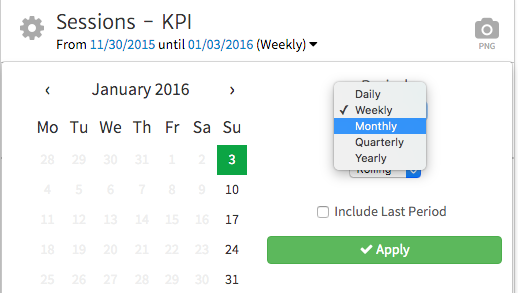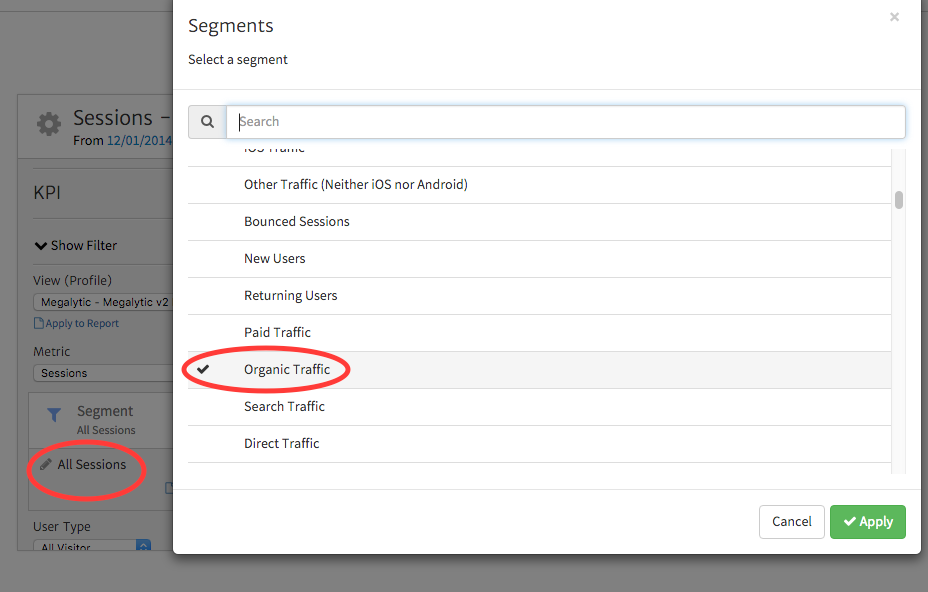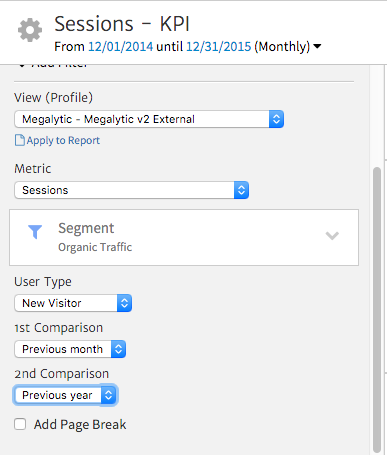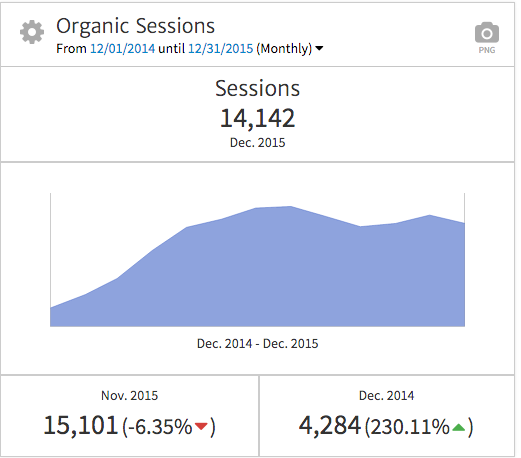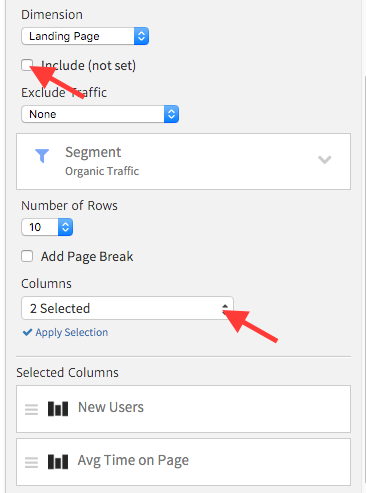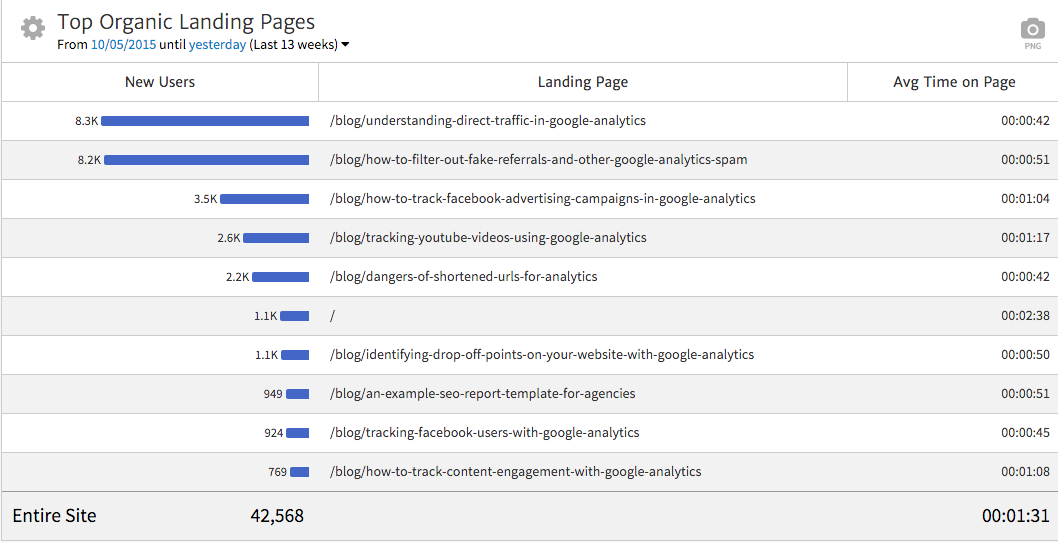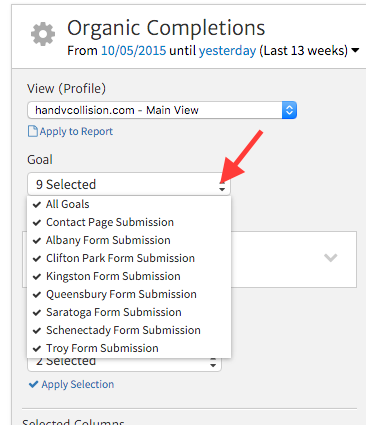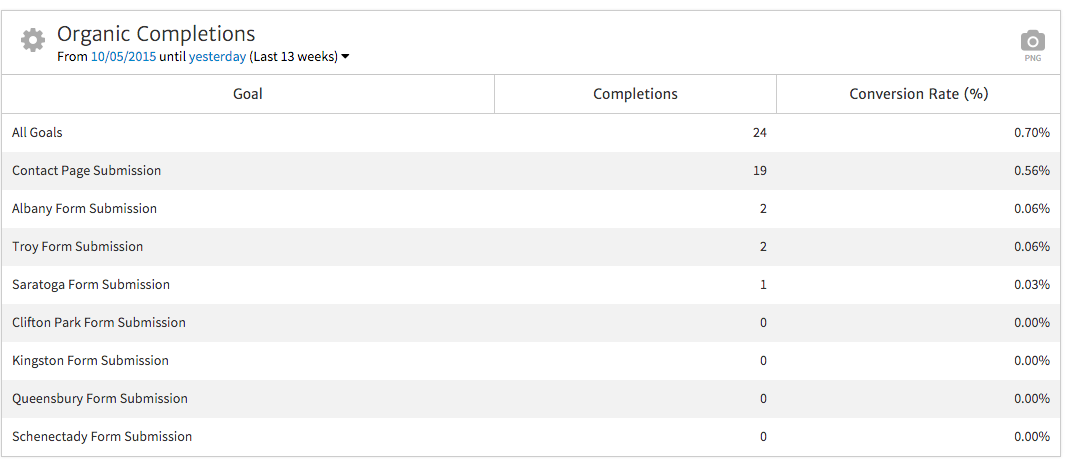
Highlight Organic KPIs
Breaking down data by page should be part of any monthly SEO analysis; however, it’s also easy for clients to get lost in complex tables and charts, especially if they’re still struggling to grasp what SEO means to their business in the first place. Sure, the marketing team may care about the nitty-gritty details, but the busy CEO will be most interested in information he or she can absorb at a glance.
Megalytic’s KPI widget helps marketers by allowing you to pick the metrics that matter most to show to your client and compare that data to previous periods (depending on how long you’ve been tracking data). For instance, you may want to show a snapshot of Users, Sessions and Goal Completions right at the top of your report.
You can use a single KPI widget to highlight one specific metric you want to call out. Look for the widget labeled simply as KPI, add it to your report and select your desired Google Analytics view. Next, customize the widget to show data for your desired timeframe: weekly, monthly, quarterly or yearly. Then, select your timeframe from the Period dropdown under the date section of the widget, and use the calendar to choose the specific date range you want.
Next, you’ll want to filter the widget to specifically show organic sessions, since we’re highlighting results from SEO. You can do this easily with either a Megalytic filter or a Google Analytics Segment; for this article we’ll use a Segment.
Under the widget options (accessible by selecting the gear icon in the upper left), find the Segment section and click the current All Sessions Segment. In the modal window that pops up, select Organic Traffic. Note that you can use the search bar to quickly find any Segment.
Once you’ve applied the new Segment to the widget, you’ll see the data update to reflect organic traffic only. Further down in the widget, you can choose what type of visitors you’d like to show. For instance, you may want to show only Sessions from new visitors to the site.
Finally, you can choose what date range comparisons to include. If your analytics account just started tracking visitors, perhaps you want to only compare to the previous month, or if you have data from a long enough timeframe, maybe you want to track both the previous month and year.
Once you’ve tweaked the widget options, you’ll see the final graph and numbers update to reflect the new settings. You can click the title of the widget to change the text; in this case, we want to label it “Organic Sessions” to reflect the type of traffic shown.
You can use multiple KPI widgets to highlight important metrics such as organic Sessions, Users, Average Session Duration and Completions. In addition, you can use the multi-KPI widget to show up to four metrics in a single widget.
Show Organic Pages
Beyond just showing KPIs, you’ll want to delve into more specific details of organic search performance on your site within your SEO report. Showing organic traffic to pages on the site allows your client to assess what content works best to attract visitors to the site.
The Landing Page widget allows us to identify pages that were a user’s first point of contact with the site – the page they “landed” on. Upon adding the widget, we’ll apply an Organic Traffic segment, just as with the KPI widget, to filter specifically to organic search visitors.
We’ll also choose to exclude “not set” pages (where a URL isn’t visible in Google Analytics) by unchecking the Include (not set) box. In addition, we’ll use the Columns dropdown to select our desired metrics. In this case, we select New Users and Avg. Time on Page to show the client new people who have discovered the site from organic search, as well as gauge how well they engaged with each page.
Once we’ve applied our changes, we’ll see the final widget with our updated metrics. Here, we can show the client the pages that have attracted the most organic traffic (articles on direct traffic and fake referrals), but also point out that the homepage and the article on tracking YouTube videos show higher engagement.
Use Notes widgets in your reports to elaborate on data for your client. You can intersperse as many of these widgets as you’d like throughout the report to call out important information, such as observations about landing page statistics.
Show Organic Conversions
Besides highlighting traffic, you should show leads and sales that came from organic search. These are the metrics that matter most to business owners, who want to correlate SEO with profit. Depending on the industry and the website, a conversion goal in Google Analytics may be a lead form submission, a newsletter signup, a registration for a free demo, or a purchase.
Assuming that you’ve set up goal tracking in Google Analytics, you can then show results from these goals in your client SEO reports. If you’re tracking more than one goal, use the Multiple Goals widget to show organic Completions for each goal on your site.
Upon adding the widget to your report, apply the Organic Traffic segment as before. You can use the Goal dropdown to choose what specific Goals you do or don’t want to include in the widget. You can also use the Columns dropdown to choose what metrics you want to show; in this case, we’ll keep the default Completions and Conversion Rate.
After configuring the widget, you’ll see a breakdown of organic Completions by Goal, along with Conversion Rate for each. Here, we can show that the majority of users are filling out the main contact page form, while location-specific forms are receiving less attention. This may identify an opportunity to make other forms more prominent across the site to increase conversion rate.
Conclusion
Once you’ve finalized your SEO report, you’ll want to save it as a template to use for future reports. See detailed instructions for creating a template from an existing report. You can now easily reuse this report format for the same client or other clients.
Templating SEO reports allows you to focus on interpreting the data for clients and spend less time manually taking screenshots or exporting spreadsheets of data from Google Analytics. Prove your worth to your client by showing the results of your search engine optimization efforts in a report that’s both informative and easy to read.
